We all should be dreaming about fall, no matter the season, because that’s when our pollinator populations are at their largest and most hungry. Remember, flower season doesn’t end in August but goes deep into October and sometimes November. Migrating insects will be looking to fuel up on nectar, some native bees will still be nesting and seeking pollen for their brood cells, and birds heading south will be on the hunt for protein-packed beetles, moths and more. Beauty abounds for us and wildlife in a native plant garden.
Here are some top picks in three groups of fall-blooming perennials that should be planted before summer heats up. Each group, as a whole, represents some of the most beneficial and attractive species for pollinators — as well as having wide ranges overall.
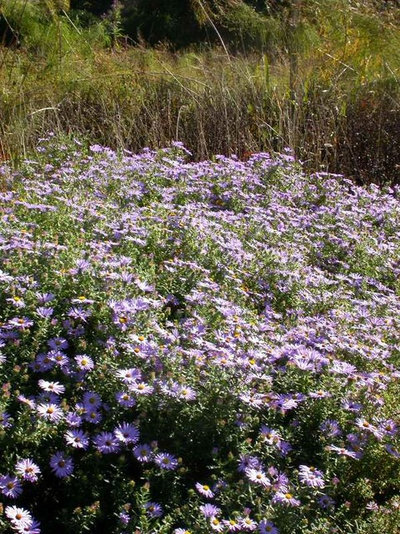
Missouri Botanical Garden
1. AstersThere are tons of aster species out there and for any location, from sunny to shady and dry to moist. There’s no excuse not to have at least a couple of species to increase the bloom time succession in your wildlife garden.
Aromatic Aster(
Symphyotrichum oblongifolium)
Native from eastern Montana south to parts of New Mexico, then east from Pennsylvania to Alabama
Absolutely one of the last plants to bloom in the wild or my garden, aromatic aster forms a shrubby mound about 18 inches tall and 2 to 3 feet wide. If you have dry soil in full sun, this aster will thank you wholeheartedly. This is an easy native flower to grow, with a shape that lends itself even to somewhat formal beds.
See how to grow aromatic aster
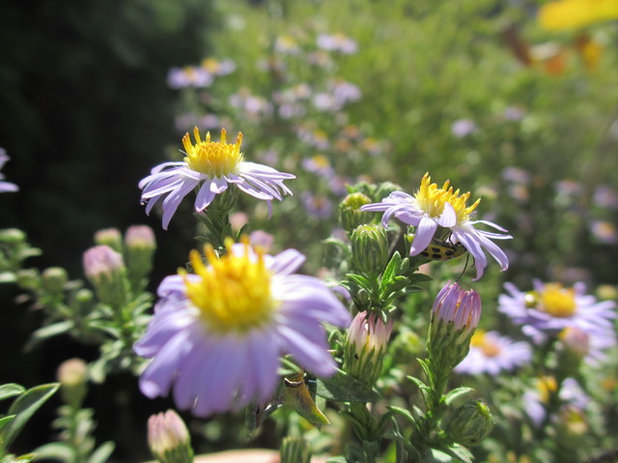
Benjamin Vogt / Monarch Gardens
Smooth Aster(
Symphyotrichum laeve)
Native from eastern Washington to Nevada and Arizona all the way to the Atlantic
I love touching my plants, and smooth aster, with its blue-tinted leaves, feels almost like a fine leather jacket. Give it full sun to part sun with a medium to even slightly dry soil, and you’re good to go. Smooth aster reaches 3 to 4 feet tall with a 1- to 2-foot spread, which makes it great for tucking among short grasses. It tends to bloom in September, no matter your location, and it will see lots of bees, moths and butterflies.
See how to grow smooth aster
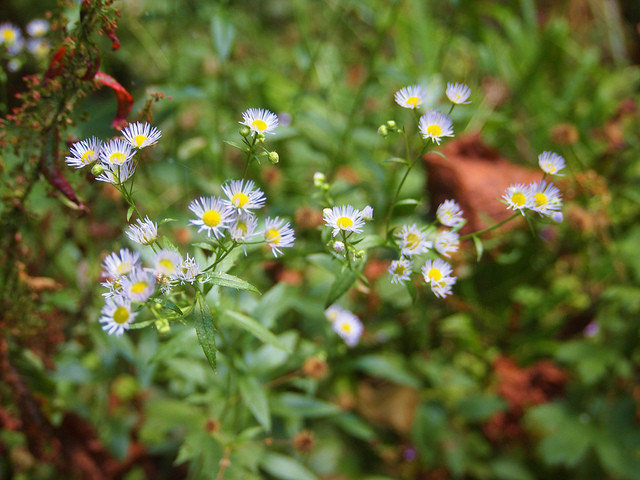 Photo by J. Maughn
Photo by J. Maughn
Pacific Aster (
Symphyotrichum chilense)
Native to California, Oregon and Washington
For gardeners in the West, this aster blooms from midsummer to early fall, starting out lavender-blue and turning white. It can take many shapes — slightly sprawling to gangly to shrubby, depending on conditions — and reaches 1 to 3 feet in height. Pacific, or California, aster is adaptable, growing on coastal bluffs, in salt marshes, on slopes and in clearings in dry to moist soil. It spreads by rhizomes, so give it room to meander among grasses or other perennials in larger beds. If planted now, Pacific aster will need more water to survive the summer heat.
6 Overlooked Asters for Tough Spots
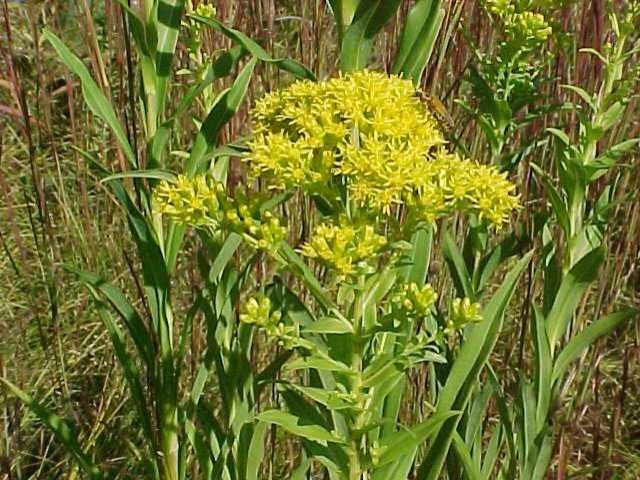
Missouri Botanical Garden
2. Goldenrods Much maligned, falsely, as the cause of hay fever, goldenrods have heavy, sticky pollen that only insects can transfer — unlike ragweed, whose hay fever-producing pollen is carried by wind. Goldenrods are some of the most important plants for pollinators, and planting a variety of species native to your area will provide a succession of flowers for a longer bloom time.
Riddell’s Goldenrod(
Solidago riddellii)
Native in a smaller range from Missouri to North Dakota, east into Michigan and Ohio
This is a goldenrod that looks like a short grass until it blooms. Preferring consistently moist soil in full sun, Riddell’s seems to prefer clay over other soil types. It will bloom anywhere from August into October with a height of 2 to 3 feet and a spread of 1 to 2 feet.
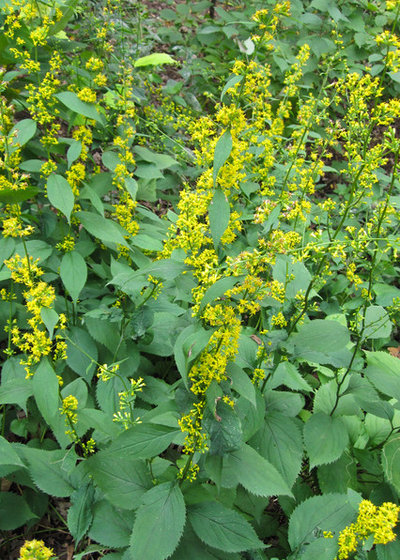
Holm Design & Consulting LLC
Zigzag Goldenrod(
Solidago flexicaulis)
Native from eastern South Dakota to eastern Oklahoma, then Maine south to northern Georgia and Alabama
I’ll admit that this is my favorite goldenrod for two reasons: It blooms in dry shade prolifically, and its fragrance reminds me of my late grandmother’s perfume. Reaching 2 to 3 feet tall and slowly spreading, even in tough clay, zigzag blooms for about 10 to 14 days, with loads of insects coming to feast. In a sunnier location (say, half sun), a bit more moisture will help it do well. Unlike many goldenrods, it is not an aggressive spreader.
See how to grow zigzag goldenrod
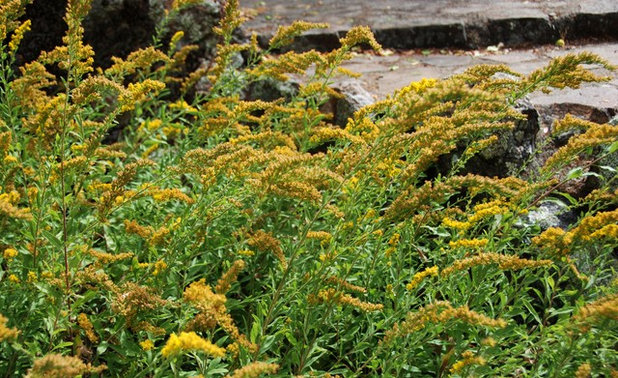
Pete Veilleux, East Bay Wilds
California Goldenrod (
Solidago velutina ssp.
californica)
Native to southwest Oregon and almost all of California
With somewhat fuzzy gray leaves and stems, California goldenrod grows best in full sun in soils from moist to dry. It reaches 3 to 4 feet tall and has individual stalks holding up clusters of blooms. It does spread by rhizomes but is reported to be easy to uproot where unwanted. This species of goldenrod may be best for larger areas. If planted now, California goldenrod will need more water to survive the summer heat.
6 Native Goldenrods Worth a Second Look
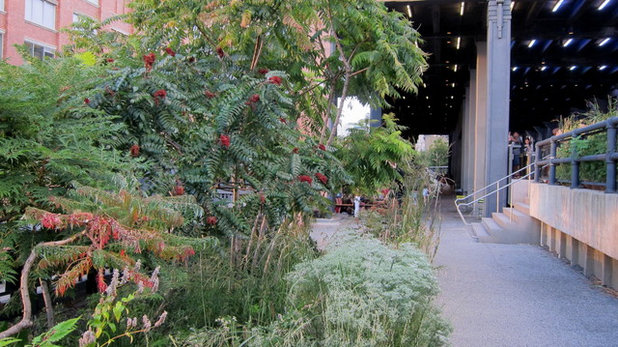 Eupatorium altissimum is pictured at bottom right. Photo by K M3. Eupatorium
Eupatorium altissimum is pictured at bottom right. Photo by K M3. EupatoriumRelatives of the more commonly planted Joe Pye weeds (
Eutrochium purpureum and
E. maculatum, most often), these plants will attract and support even more adult insects in the late flowering season.
Tall Thoroughwort(
Eupatorium altissimum)
Native from South Dakota to northern Texas, east to southern New England and northern Florida
Blooming anywhere from August into October, tall thoroughwort, also called tall boneset, reaches about 3 to 6 feet tall and 3 feet wide. Somewhat adaptable from slightly moist to slightly dry soils, it prefers full sun to 75 percent sun for maximum flowering. You’ll notice an abundance of beneficial soldier beetles on bonesets in early summer, as well as countless bees, flies, wasps, moths and butterflies. Medium soils are best, and it can handle clay like a champ.
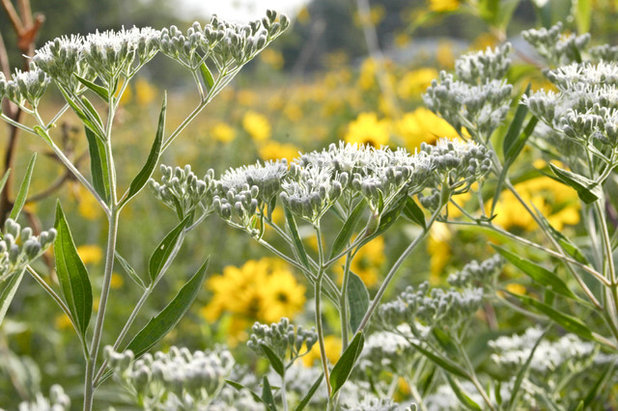 Photo by Frank MayfieldLateflowering Thoroughwort
Photo by Frank MayfieldLateflowering Thoroughwort(
Eupatorium serotinum)
Native from Nebraska to Texas, east from Massachusetts to Florida
Almost identical in appearance to tall thoroughwort, lateflowering thoroughwort, also called late boneset, is more plentiful in a similar native range and tends to be a bit taller, at 5 to 7 feet. It tends to bloom a little later than its cousin, so if you plant both, you’ll get an even longer succession of white blooms — perfect for a moon garden on cool autumn evenings. It prefers the same growing conditions as
E. altissimum.More What to do in your garden now
Learn how to find native plants for your yard





